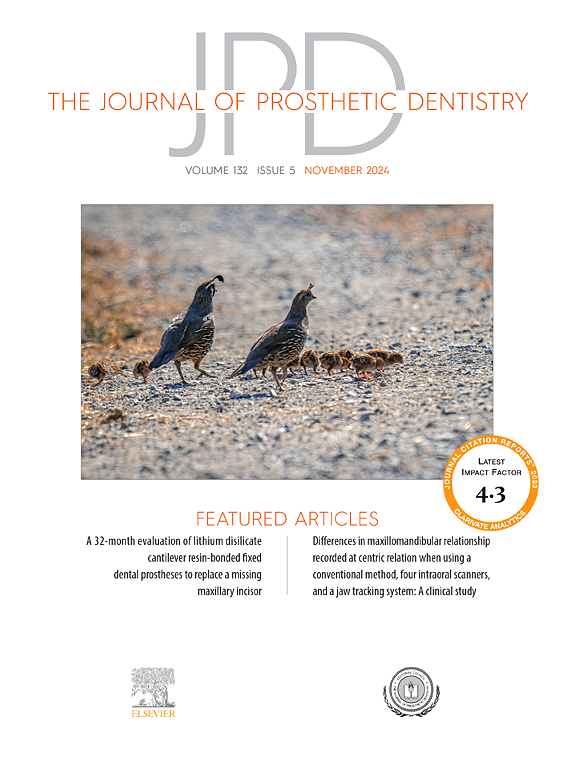Effect of a digital assessment system for the preclinical tooth preparation of metal-ceramic crowns: A pilot study
IF 4.8
2区 医学
Q1 DENTISTRY, ORAL SURGERY & MEDICINE
引用次数: 0
Abstract
Statement of problem
Tooth preparation is a fundamental aspect of prosthodontics and serves as a focal point in preclinical courses. Conventional pedagogy relies heavily on the expertise of instructors, whereas digital technology has the potential to offer instantaneous feedback. The efficacy of a digital assessment system in comparison with traditional teaching methods remains uncertain.
Purpose
The purpose of this study was to compare the training effects of traditional assessment and digital evaluation on tooth preparations for the metal-ceramic crowns performed by preclinical students on the convergence angle and tooth reduction.
Material and methods
A total of 40 predoctoral students were randomly divided into the digital group and the traditional group to complete tooth preparation for a metal-ceramic crown on a left mandibular first molar. Students in the traditional group were taught by an experienced instructor, while the digital group students were trained by an objective digital assessment system without instructor guidance. Each student completed the tooth preparation in 20 min, received feedback according to the respective training methods, and later prepared another tooth. In this way, all students completed 4 tooth preparations in 2 weeks. All preparations were evaluated by an optical scanner. Parameters for comparing the digital group with the traditional group were the convergence angle and reduction at different stages. Questionnaires on the digital training system were answered by the students of the digital group. The t tests or Wilcoxon signed rank tests and chi-squared tests were used to analyze the differences between the 2 groups (α=.01).
Results
A decreasing trend in convergence angle was seen in both groups, but the 2 groups were statistically similar (P>.01). After training, a decreasing trend was seen in under-reduction and overreduction on 5 surfaces in the digital group. Conversely, in the traditional group, a noteworthy increase was seen in under-reduction on the distal surface (P=.002). Nevertheless, no significant difference was found between the 2 groups (P>.01). According to the results of the questionnaire, over 80% of the students had a positive attitude toward the digital assessment system, and more than 80% of the students expressed their interest in the digital assessment system for tooth preparation training.
Conclusions
Traditional teaching and digital feedback provided similar training effects to improve the quality of tooth preparations for preclinical dental students.
数字评估系统对金属陶瓷牙冠临床前牙齿制备的影响:一项初步研究。
问题陈述:牙齿预备是口腔修复学的一个基本方面,也是临床前课程的重点。传统的教学法在很大程度上依赖于教师的专业知识,而数字技术有可能提供即时反馈。与传统教学方法相比,数字评估系统的效果仍然不确定。目的:本研究的目的是比较传统评估和数字评估对临床前学生进行的金属陶瓷牙冠牙齿预备的会聚角和牙齿复位的训练效果。材料和方法:将40名大四前学生随机分为数字化组和传统组,完成左下颌第一磨牙金属陶瓷冠的牙齿预备。传统组的学生由经验丰富的讲师授课,而数字组的学生则在没有讲师指导的情况下由客观的数字评估系统进行培训。每个学生在20分钟内完成了牙齿预备,并根据各自的训练方法收到反馈,随后准备了另一颗牙齿。通过这种方式,所有学生在2周内完成了4次牙齿预备。所有制剂均通过光学扫描仪进行评估。将数字群组与传统群组进行比较的参数是不同阶段的收敛角度和缩减。数字小组的学生回答了关于数字培训系统的问卷。使用t检验或Wilcoxon符号秩检验和卡方检验来分析两组之间的差异(α=.01)。相反,在传统组中,远端表面的缩小不足显著增加(P=0.002)。然而,两组之间没有发现显著差异(P>0.05)。根据问卷调查结果,超过80%的学生对数字评估系统持积极态度,超过80%的学生表示他们对牙齿预备训练的数字评估系统感兴趣。结论:传统教学和数字反馈提供了相似的训练效果,可以提高临床前牙科学生的牙齿预备质量。
本文章由计算机程序翻译,如有差异,请以英文原文为准。
求助全文
约1分钟内获得全文
求助全文
来源期刊

Journal of Prosthetic Dentistry
医学-牙科与口腔外科
CiteScore
7.00
自引率
13.00%
发文量
599
审稿时长
69 days
期刊介绍:
The Journal of Prosthetic Dentistry is the leading professional journal devoted exclusively to prosthetic and restorative dentistry. The Journal is the official publication for 24 leading U.S. international prosthodontic organizations. The monthly publication features timely, original peer-reviewed articles on the newest techniques, dental materials, and research findings. The Journal serves prosthodontists and dentists in advanced practice, and features color photos that illustrate many step-by-step procedures. The Journal of Prosthetic Dentistry is included in Index Medicus and CINAHL.
 求助内容:
求助内容: 应助结果提醒方式:
应助结果提醒方式:


